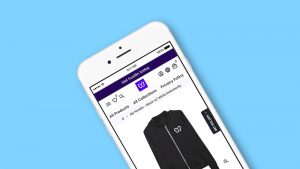14 Most Essential Ways To Increase Conversions On Your Shopify Store

Getting traffic is an essential factor for the success of the eCommerce business. If the eCommerce store has no visitors, there’ll be no conversions, no sales, and consequently, no profit.
Hence, marketers have to ensure huge traffic on their online stores to increase their conversion rate and grow their online store. However, simply getting the visitors to the store doesn’t guarantee increased conversion and profits. An eCommerce store must provide the visitors with an unforgettable experience to convert them.
Did you know that failure to provide a good user experience can lead 89% of your customers to shop with a competitor?
But don’t worry, now your visitors will not leave empty-handed from your store.
Because in today’s article, we have put together an overview of effective tips and tricks to boost website traffic and increase conversion on your store.
Ready? Let’s begin…
14 Most Essential Ways To Increase Conversions On Your Shopify Store
1. Write Compelling Product Description
Another important way to increase conversion on your Shopify store is by writing compelling and catchy product descriptions. Write your product description by keeping in mind your buyers. Address their pain points, interests, and needs. Your product description shouldn’t rave about how remarkable or unique it is from the rest of the products in the market. Customers are not interested in such information. What they’re interested in is how your product can solve their problems or benefit them.
Your product descriptions should convince the buyer that purchasing the products will be beneficial for him. Use simple and easy-to-understand language for product descriptions. Use your core keywords in the description to rank higher on search engine result pages and drive traffic to your store.
Refrain from using the manufacturer’s product description. Instead, create unique descriptions for the products in your store. Don’t forget to use a voice and tone that resonates with your brand. For example, using a stern tone for marketing teenage products is not suitable. Likewise, using fun and quirky language for selling medical products will not bring desired results.
2. Update Your Theme
The first impression is the last.
And let’s not forget that last impressions are the lasting impression. Your theme is the first thing your visitors will observe after landing on your eCommerce store. Thus, ensure that your theme makes the visitor feel welcomed and not annoyed.
It takes just 50 milliseconds for visitors to decide to stay at your store or exit it. Therefore, your theme should be powerful enough to make a good impression on the visitors and customers.
Look for the following features before selecting your theme:
Aligns With Your Brand
The layout, colors, design, and fonts should match your brand and appear pleasing to the customers. For instance, an online store that sells baby items would look dismal with dark or monochromatic colors. Similarly, a brand that sells clothes for senior citizens will not select a theme with neon or popping bright colors.
Easy To Navigate
Not every visitor on your website would be a tech expert. Hence, keep a navigation menu that is simple and easy for everyone to use.
Mobile-Friendly
More than half of the web traffic is generated via mobile devices. Therefore, failure to have a mobile-optimized store can lead to loss of massive traffic.
Loads Quickly
Ideally, a website should load in 3 seconds. If the website takes longer than 3 seconds to load, it can lose a good amount of traffic, affecting its conversion rate.
3. Upload High-Quality Images And Videos
When visitors enter your Shopify store, they cannot touch, hold, or try on the product. Instead, they make their purchasing decision solely based on the products and videos of the product displayed by the seller.
Hence, endeavor to upload high-resolution pictures on your eCommerce store. Clear and high-quality images make it easier for the consumer to get a closer view of the product and be completely satisfied before purchasing it.
Add the feature of zooming-in to allow the customer to check the details, such as the designing, embroidery, texture, etc. In addition, upload multiple pictures of the products from different angles. It also helps the customer check how the products look from every angle before placing an order.
Apart from adding high-resolution pictures, display product videos, especially if your products need a demonstration for assembling or using it.
4. Offer FREE Shipping
Offering free delivery works like magic to attract customers to your eCommerce store. People do not hesitate to order goods from a new website if it offers free shipping.
When companies offer free delivery, consumers only have to pay for the goods and not the shipping charges; this makes them spend more on shopping for their favorite articles.
79% of customers have stated that they feel more inclined to shop from a brand if it offers free delivery.
Offer free shipping to your customers to attract hefty traffic to your eCommerce store to increase your conversions and boost your online sales.
If your business cannot afford to offer free delivery, no problem. You can set a threshold of spending, after which the buyers can avail of free delivery. For instance, many stores offer free delivery on shopping above $150, etc.
You can do the same!
Your customers won’t mind spending a little extra money on their favorite articles instead of paying for the shipping.
5. Hold Sales And Offer Discounts
Let us ask you a simple question.
How many of you don’t like discounts and sales?
Please raise your hand!
Stupid question, right? Everybody loves to avail of discounts and sales to get their favorite goods at slashed prices. Thus, hold sales on special occasions like New Year’s Eve, Christmas, Halloween, etc. You can also announce impromptu sales to generate traffic and clear your old stock.
To make your sales an immense success, ensure to announce it on various channels to inform your customers, such as on your social media profiles, sending newsletters and SMS to your customers, running paid ads, etc.
Also, offer a special discount code to your new customers in exchange for their email addresses or mobile numbers. People will hurry up to use their discount codes before they expire or become invalid.
6. Strategically Display Customer Reviews
Reviews shared by your customers can serve as a powerful tool to persuade your visitors to turn into your customers. Thus, always display the reviews shared by your customers with your prospective audience.
Customers have become accustomed to reading online reviews before finalizing their purchases. However, the absence of reviews on your website might make the prospect turn his back to your eCommerce store.
Around 95% of online buyers read reviews, and 91% of buyers trust online reviews like a personal recommendation from their friends or family. Therefore, the presence of reviews on the website makes your business appear credible and authentic. Moreover, when people express good things about a brand and rave about the products, other people are enticed to use the products to get the same benefits.
7. Streamline Checkout Process
All your efforts of engaging the customer and keeping him to your website will be rendered futile if the customer exits your website without completing the checkout process.
Cart abandonment at the checkout stage is heart-wrenching for all the eCommerce stores. Hence, make your checkout process short, simple, and smooth.
Did you know 12% of customers abandon their carts if the checkout process is long and complicated? Therefore, keep your order forms short and do not ask for irrelevant information. Also, keep the option of guest checkout to allow the customers to checkout without creating a separate account on the website.
14% of the customers exit the website if there is no guest checkout option available on the website.
Make your checkout process quick and smooth so that the customer doesn’t change his mind about purchasing your products. Make your customers leave the website when they’ve shared their credit card details with you and finalized their orders.
8. Add A Live Chat Option
When people shop in a brick-and-mortar business model, it is pretty easy for them to ask their questions and concerns from a sales rep. However, it is difficult for the customers to seek help instantly from the business or sales rep in online shopping. Therefore, sometimes it results in the loss of customers, and ultimately the profit that could’ve been earned from him.
The simple solution to bridge the distance between the customer and an online sales rep is to integrate live chat. The customer can easily connect with the sales rep and share his concerns and queries. According to 44% of customers, having a live chat on the website is a valuable feature offered to them by the company.
If the customer has a question from the business, he can use the live chat feature to quickly get his answer within a few minutes without using the formal channels of call or email to the company.
9. Run Retargeting Ads
Not all the visitors will turn into your customers. Some visitors will enter your eCommerce store, explore the products, and leave your website. An enthusiastic entrepreneur goes after the visitors, reminds them about the products, and entices them to purchase them.
If you, too, want your interested audience to come back to your website and purchase their favorite items, all you have to do is run retargeting ads.
Did you know that around 26% of consumers return to the website because of retargeting ads? Retargeting ads work as a reminder. It reminds the prospect about the goods he liked at a store and tempts him to revert to the website to order them.
10. Upsell And Cross-sell Your Products
Another way to convert your visitors is by deploying the tactic of upselling and cross-selling at your store.
Upselling means selling your customer an upgraded version of the item he is interested in purchasing. For example, a customer is interested in buying a regular pizza for $60. The store can suggest that he buy a regular pizza along with the side of salad and wings for $68. The customer will not hesitate to spend $8 to upgrade his order.
On the contrary, cross-selling is to suggest items that complement the customer’s purchase. Thus, the store can display the pair of mittens to the customer who has brought a scarf or coat.
When visitors see all the things he is interested in buying at one place, they are most likely to convert.
11. Start Content Marketing Program
Blogging has become a compulsion for every type of business, irrespective of its size and niche.
Creating and publishing content on a website enables the business to integrate the core and related keywords to increase its visibility and score higher on search engine result pages.
Therefore, create useful, interesting, and engaging content for your audience. Rank up higher on search results to increase traffic and your conversions.
12. Leverage User-Generated Content
Leveraging user-generated content is a fantastic strategy to increase conversions and display social proof of your business’s products. When visitors arrive at your store and watch the pictures of the customers using your product, they find it easier to trust you and feel confident in buying your products.
If your customers have used your products and shared the picture with you or uploaded a photo on their social media profile and tagged you, don’t limit it to yourself. Instead, take the user’s prior permission and repost his images on your website or social media profiles to attract the audience and generate social proof.
When visitors see other people using your products and benefitting from them, they are motivated to purchase and convert as your customers.
13. Optimize Your Product Pages
Product pages are the most crucial part of any eCommerce website. Hence, make sure that your product pages are neatly organized into categories and sub-categories. Do not display all the goods on one page, especially if you have various products. Always create separate pages to quickly enable the user to find his desired products quickly without having to scroll pages frantically.
In addition, don’t forget to add a search and filter option on the website. Let your prospect quickly find the products by typing for it to select the preset filters.
14. Get Social
People will visit your website and convert as your customers when they know about your business and what kind of products you sell. Hence, it has become mandatory for every business enterprise to integrate social media marketing into their marketing strategies.
Social media has 3.96 billion active users, giving entrepreneurs the perfect opportunity to promote their brands.
Social networking websites like Facebook, Instagram, Snapchat, Twitter, etc., are completely free to join. As a result, the company can create its profile, advertise its products, and engage with its audience.
But these aren’t the only benefits of social media marketing…
Facebook and Instagram also enable entrepreneurs and marketers to sell their goods directly on social networking websites. Customers can scroll the posts, and if they like the product, they can buy it then and there; without having to go to the business’s website.
Conclusion
Alright…that’s the wrap for today!
We hope that these tips help you create a high-converting Shopify store.
Do you have any questions or queries regarding this article? Please share it in the comments below. Our competent team will revert to you at their earliest.
Author Bio:
Ricky Hayes is the Co-Founder and Head of Marketing at Debutify – a free Shopify theme, helping dropshippers build high-converting stores in minutes. He is a passionate entrepreneur running multiple businesses, marketing agencies, and mentoring programs.



 Luther of Keezy.co: Digital Marketing Wizardry
Luther of Keezy.co: Digital Marketing Wizardry  Maximize Brand Reach: Top PR Strategies for All Platforms
Maximize Brand Reach: Top PR Strategies for All Platforms  Optimizing Your Compensation: The Role of a Personal Injury Attorney After an Accident
Optimizing Your Compensation: The Role of a Personal Injury Attorney After an Accident  How to Get Started With CTV Advertising in Albuquerque, NM?
How to Get Started With CTV Advertising in Albuquerque, NM?  Transforming Homes with Flooring Advantages in Lewisville, TX
Transforming Homes with Flooring Advantages in Lewisville, TX  Strategies for Optimizing Email Monetization Performance
Strategies for Optimizing Email Monetization Performance